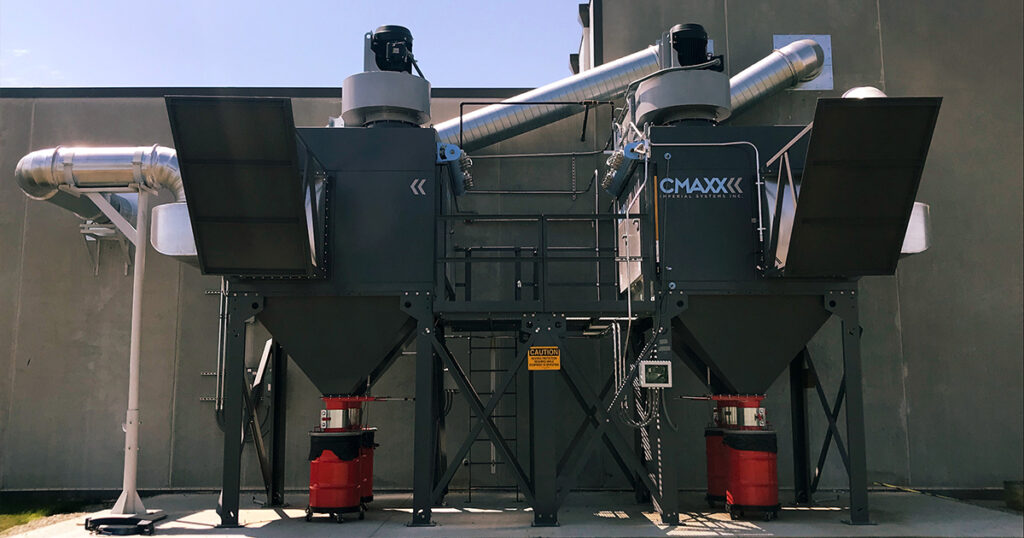
Designing a dust collection system? Updating your dust control equipment? You’ll need to understand the basics of one important concept in fluid mechanics: static pressure. If you remember any physics lessons from your youth, you might guess correctly that the fluid we’re talking about is air. It’s the driving force that captures and conveys combustible dust from the manufacturing process, and integral to an efficient dust collection system.
Acquire a better understanding of the role of dust collector static pressure in the design and operation of an integrated air environment.
What Is Static Pressure?
Static pressure is the pressure—the force per unit area—that a fluid places on an at-rest surface. In an industrial dust collection system, it refers to the total degree of resistance in an airstream. In other words, the resistance that the air encounters as it passes through the inner workings of a dust collector system. This static pressure is created when a fan or any other air moving component is used to push or pull air through a dust collection system.
Similar to differential pressure, which is the difference in pressure between two points, static pressure is often measured in inches of water. You may see static pressure written as SP and represented in units like inches of water (in. H2O), inches of water column (in. wc.), inches of water gauge (in. wg.), or pascals (Pa).
Dust collectors are built with gauges that can help industrial workers and maintenance professionals more accurately determine this level to ensure high equipment efficiency and performance. In addition to fan and blower pressures, these gauges can display pressure drop across filter media, calculate airflow rates, and determine remaining filter media life.
How Does Static Pressure Work?
All air possesses mass and becomes subject to friction that slows down its velocity. The faster the air, the stronger the frictional forces. This resistance is formed from the air moving through and around materials and obstacles. In dust collectors, these could be filter media, fume hoods, ductwork, and hoses.
Activating a dust collection system creates pressure within the system components (ductwork, material separators, dust filters, etc.) that moves the air at speeds that are sufficient to keep dust particles moving through the system. As it moves, every elbow, branch, and point of transition works against it, contributing their own air resistance coefficient in the geometric layout of the equipment. This is known as static pressure loss.
To work effectively, the air handling fans must help the conveyance air overcome the resistance to flow over the full range of operating conditions and filter media service life.
Using all air resistance coefficients and the transport velocity of a dust collection system’s fan, you can calculate the total degree of resistance in the airstream to find the total static pressure of an industrial dust control system.1 The static pressure is the fan’s total pressure minus the fan’s outlet velocity pressure. When you understand how static pressure works in this environment, you can also perform a dust collector pressure drop calculation to monitor the performance of your equipment.
Why Is Static Pressure Important?
Not only are spark detection systems important, static pressure plays a bigger role in dust collection system design than in HVAC work. When you design or upgrade an integrated dust collection system for your process, you’ll need to factor in the pressure drop of each system component at the desired conveyance velocity to determine the entire system pressure drop under both initial filter media pressure drop, as well as at “end of life” filter media pressure drop.
Knowing the total static pressure appropriate for your specific application will help you select the size and type of fan needed to move the process air under this range of conditions.
Fans are given a rating that indicates a specific amount of cubic feet per minute (CFM) that they can achieve against specific amount of static pressure. A typical material or air handling fan may have an air handling design rating of 10,000 CFM at 12″ S.P. If this is the only fan in the system the CFM rating can be used to calculate air-to-cloth ratio for a given type of dust collector handling a particular type of dust.
A dust collector fan with an inadequate amount of CFM won’t be strong enough to push the air, meaning the fan won’t achieve the required conveyance velocity, the system won’t perform as intended, and the dust will not be effectively moved through the dust collection system. If this dust is combustible or flammable there could be serious fire and explosion risks. In other words, the size or CFM of an air or material handling fan is absolutely critical in designing a safe, effective, and compliant dust collection system.
Purchasing the wrong size dust collector, installing it without the help of professionals, or failing to properly maintain a dust collection system will result in poor dust collection, inefficient production operations, poor end product quality, and unsafe conditions. If your dust collection system isn’t operating properly, contact a qualified professional with experience in your industry to identify and correct any issues before they become a more expensive problem for your team.
Negative Effects of High Static Pressure
- Poor/low conveyance velocity
- Poor suction/poor dust collection
- Wasted energy
- Potential fire and explosion risk
- Low productivity
- Poor indoor air quality
- Machinery breakdowns
- Production interruptions
Be sure to fully understand and carefully calculate static pressure under the full range of operating conditions for your process.
If you’re not sure what type of dust collector you need or where to start when it comes to static pressure calculations, feel free to get in touch with AES. Our experts have installed countless industrial dust control units that help businesses obtain greater profitability, productivity, and sustainability in their manufacturing operations.
Searching for dust collection or recycling equipment for sale? Check out our new and used equipment inventory and find the best solution for your facility.
Sources
1. Dust Collection System Design Part 3: Calculating Total Static Pressure, Eldridge
